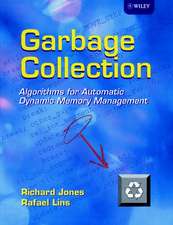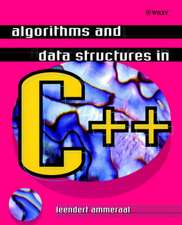Handbook of Logic and Proof Techniques for Computer Science
Autor Steven G. Krantzen Limba Engleză Paperback – 23 oct 2012
| Toate formatele și edițiile | Preț | Express |
|---|---|---|
| Paperback (1) | 331.08 lei 6-8 săpt. | |
| Birkhäuser Boston – 23 oct 2012 | 331.08 lei 6-8 săpt. | |
| Hardback (1) | 338.16 lei 6-8 săpt. | |
| Birkhäuser Boston – 17 ian 2002 | 338.16 lei 6-8 săpt. |
Preț: 331.08 lei
Preț vechi: 413.85 lei
-20% Nou
Puncte Express: 497
Preț estimativ în valută:
63.36€ • 68.80$ • 53.22£
63.36€ • 68.80$ • 53.22£
Carte tipărită la comandă
Livrare economică 22 aprilie-06 mai
Preluare comenzi: 021 569.72.76
Specificații
ISBN-13: 9781461266198
ISBN-10: 146126619X
Pagini: 268
Ilustrații: XIX, 245 p.
Dimensiuni: 155 x 235 x 14 mm
Greutate: 0.38 kg
Ediția:Softcover reprint of the original 1st ed. 2002
Editura: Birkhäuser Boston
Colecția Birkhäuser
Locul publicării:Boston, MA, United States
ISBN-10: 146126619X
Pagini: 268
Ilustrații: XIX, 245 p.
Dimensiuni: 155 x 235 x 14 mm
Greutate: 0.38 kg
Ediția:Softcover reprint of the original 1st ed. 2002
Editura: Birkhäuser Boston
Colecția Birkhäuser
Locul publicării:Boston, MA, United States
Public țintă
Professional/practitionerCuprins
1 Notation and First-Order Logic.- 1.1 The Use of Connectives.- 1.2 Truth Values and Truth Tables.- 1.3 The Use of Quantifiers.- 1.4 Gödel’s Completeness Theorem.- 1.5 Second-Order Logic.- 2 Semantics and Syntax.- 2.1 Elementary Symbols.- 2.2 Well-Formed Formulas or wffs [Syntax].- 2.3 Free and Bound Variables (Syntax).- 2.4 The Semantics of First-Order Logic.- 3 Axiomatics and Formalism in Mathematics.- 3.1 Basic Elements.- 3.2 Models.- 3.3 Consistency.- 3.4 Gödel’s Incompleteness Theorem.- 3.5 Decidability and Undecidability.- 3.6 Independence.- 4 The Axioms of Set Theory.- 4.1 Introduction.- 4.2 Axioms and Discussion.- 4.3 Concluding Remarks.- 5 Elementary Set Theory.- 5.1 Set Notation.- 5.2 Sets, Subsets, and Elements.- 5.3 Binary Operations on Sets.- 5.4 Relations and Equivalence Relation.- 5.5 Equivalence Relations.- 5.6 Number Systems.- 5.7 Functions.- 5.8 Cardinal Numbers.- 5.9 A Word About Classes.- 5.10 Fuzzy Set Theory.- 5.11 The Lambda Calculus.- 5.12 Sequences.- 5.13 Bags.- 6 Recursive Functions.- 6.1 Introductory Remarks.- 6.2 Primitive Recursive Functions.- 6.3 General Recursive Functions.- 7 The Number Systems.- 7.1 The Natural Numbers.- 7.2 The Integers.- 7.3 The Rational Numbers.- 7.4 The Real Numbers.- 7.5 The Complex Numbers.- 7.6 The Quaternions.- 7.7 The Cayley Numbers.- 7.8 Nonstandard Analysis.- 8 Methods of Mathematical Proof.- 8.1 Axiomatics.- 8.2 Proof by Induction.- 8.3 Proof by Contradiction.- 8.4 Direct Proof.- 8.5 Other Methods of Proof.- 9 The Axiom of Choice.- 9.1 Enunciation of the Axiom.- 9.2 Examples of the Use of the Axiom of Choice.- 9.3 Consequences of the Axiom of Choice.- 9.4 Paradoxes.- 9.5 The Countable Axiom of Choice.- 9.6 Consistency of the Axiom of Choice.- 9.7 Independence of the Axiom of Choice.- 10 Proof Theory.-10.1 General Remarks.- 10.2 Cut Elimination.- 10.3 Propositional Resolution.- 10.4 Interpolation.- 10.5 Finite Type.- 10.6 Beth’s Definability Theorem.- 11 Category Theory.- 11.1 Introductory Remarks.- 11.2 Metacategories and Categories.- 12 Complexity Theory.- 12.1 Preliminary Remarks.- 12.2 Polynomial Complexity.- 12.3 Exponential Complexity.- 12.4 Two Tables for Complexity Theory.- 12.5 Problems of Class P.- 12.6 Problems of Class NP.- 12.7 NP-Completeness.- 12.8 Cook’s Theorem.- 12.9 Examples of NP-Complete Problems.- 12.10 More on P/NP.- 12.11 Descriptive Complexity Theory.- 13 Boolean Algebra.- 13.1 Description of Boolean Algebra.- 13.2 Axioms of Boolean Algebra.- 13.3 Theorems in Boolean Algebra.- 13.4 Illustration of the Use of Boolean Logic.- 14 The Word Problem.- 14.1 Introductory Remarks.- 14.2 What Is a Group?.- 14.3 What Is a Free Group?.- 14.4 The Word Problem.- 14.5 Relations and Generators.- 14.6 Amalgams.- 14.7 Description of the Word Problem.- List of Notation from Logic.- Glossary of Terms from Mathematical and Sentential Logic.- A Guide to the Literature.
Recenzii
"This is really what it promises to be—a good handbook: supple, self-contained, providing the necessary and sufficient working resources . . . it is more than [one] expect[s]: the rigor of usefulness and conciseness exceeds or equals . . . the pleasure of reading it."
—Zentralblatt Math
—Zentralblatt Math










